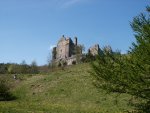
Neidpath
castle
Neidpath Castle is a rubble built L-plan tower house dating mostly to the 14th century and located about 1 mile west of Peebles on A72 (Peebles to Glasgow road)
It is unusual in that the tower is not actually square, but each wing is a parallelogram, with rounded corners. It is built with a peculiar hard mortar not usually seen in scottish castles, and is presumed to be of Norman construction, like the tower of london. It is so hard that a staircase was dug out in the exterior wall in the 17th century without damaging the structure.
Home to the Fraser's at an early date, the last of this line was Sir Simon Fraser, famed for defeating the English three times in one day at Rosslyn Moor in 1302. He was later captured by them and put to death. It is thought there was a tower here at that time. It passed by marriage to the Hays in 1312, (his daughter and heiress married Gilbert de Haya of Yester) who built the existing castle. Neidpath was known as Jedderfield until the 16th century. and it remained a Hay possession until the end of the 17th century. The new owners added gardens and trees to the estate. Neidpath Castle (as opposed to the original tower that stood here) originally belonged to the Hays of Yester. Probably built for Sir William de Haya, Sheriff of Peebles, who died in 1390. James VI stayed at Neidpath in 1587.
However, the Hays were royalists, and Neidpath has the notable honor of withstanding Cromwell's attacks longer than any other fortification south of the Forth (From 1650-1651). Cannon finally damaged the castle, and it was surrendered. In 1685 or '86 the estate was bought by the first Duke of Queensberry for his son, William Douglas, Earl of March. The third Earl of March died with no heir and the estate went to the fourth Duke of Queensberry. A large section of the south wall and part of the upper level's were badly damaged during the siege, this is still visible today.
The 5th Earl rebuilt the main block soon after, partially roofing the parapet to form galleries with square turrets and adding a garret storey, the original roof was flat. He also planted an avenue of yew trees on the approach to the castle. The Duke allowed the estate to fall into ruin by cutting down the ornamental trees and allowing the gardens to be overgrown. It was neglected, and the upper part of the wing of the tower collapsed by 1790. In 1810 the Earl of Wemyss inherited the title - Earl of March along with Neidpath Castle and estate. When the earl died in 1810, the castle passed to the Earls of Wemyss, (the current owners). Only the tower main block and rebuilt south range remained roofed. The upper floors were remodelled in the 16th century, when the partially enclosed parapet was added. More alterations were carried out by the 2nd Earl of Tweeddale in the 17th, when the ground floor was remodelled, a new stairway inserted and a sub-dividing floor was added below the vault of the hall. Restorations continue today in the cellars and in many of the still-plastered rooms above. The original entrance was in the re-entrant angle but the 5th earl moved it to the centre of the east wall. Both ground floor rooms are vaulted and there is a turnpike stair in the thickness of the south wall. The first floor has a room in the wing and a wide stair leading up to the hall on the second floor. Another turnpike in the north - west angle gives a third route for access to the upper levels. The third floor is also vaulted. The carved keystone of the arched gateway displays the goat's head emblem of the Hay's, Earl's of Tweeddale.
Except for the ruined 16th century bakehouse and brewhouse in the southeast corner of the courtyard, nothing remains of the builders of the 1660s and later. The north wall has mostly gone and the east range was again remodelled in 1780. It was left as a consolidated ruin in 1950. The castle is still in private ownership today.
Neidpath is reputedly haunted by a young woman. She fell in love with a local laird, but her father did not think he was good enough for her. She pined away until her father recalled the young man. She waited on the ramparts for him to return, but she so changed by her illness that he rode right past, not recognizing her. She died.